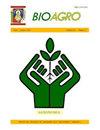Response of melon cultivars to infection by Macrophomina pseudophaseolina isolates and its effect on protein expression
IF 0.7
4区 农林科学
Q4 AGRONOMY
引用次数: 0
Abstract
It was studied the pathogenicity of Macrophomina pseudophaseolina isolates in melon seedlings and their influence on protein expression of the crop. For this purpose, two isolates of the fungus were inoculated in Golden and Cantaloupe melon seedlings using the toothpick method. Thirty days after inoculation, disease incidence and severity were assessed using pre-established scales; additionally, stem and root length and fresh weight was evaluated. Protein extraction from plant tissues was performed using the phenol/SDS precipitation method and quantification by the Bradford method. The protein samples were subjected to denaturing polyacrylamide gel electrophoresis (SDS-PAGE). Then, the existence of polymorphism and molecular weight of bands detected in the samples were evaluated. M. pseudophaseolina isolates caused root rot in all inoculated melon seedlings. However, the two isolates exhibited different degrees of aggressiveness to the seedlings. The isolates CMM-4801 and CMM-4771 caused an average symptom severity of 3.40 and 2.60, respectively, in both cultivars. The disease negatively affected seedling development by reducing root length, and stem and root fresh weight. Different polypeptide band patterns were verified between inoculated and control seedlings, indicating different protein expression due to biotic stress caused by the fungus. Moreover, different protein expression patterns were found between the inoculated seedlings, indicating a correlation between pathogen aggressiveness and host response.甜瓜品种对伪相巨噬菌感染的反应及其对蛋白表达的影响
研究了拟相球大磷虾分离株在甜瓜幼苗中的致病性及其对作物蛋白质表达的影响。为此,用牙签法将两株真菌分别接种在金瓜和哈密瓜幼苗中。接种后30天,使用预先建立的量表评估疾病发生率和严重程度;此外,还对茎根长度和鲜重进行了评价。使用苯酚/SDS沉淀法从植物组织中提取蛋白质,并通过Bradford法进行定量。对蛋白质样品进行变性聚丙烯酰胺凝胶电泳(SDS-PAGE)。然后,对样品中检测到的条带的多态性和分子量进行评估。假相球孢M.pseudo-phaseolina分离株在所有接种的甜瓜幼苗中引起根腐病。然而,这两个分离株对幼苗表现出不同程度的攻击性。分离株CMM-4801和CMM-4771在两个品种中的平均症状严重程度分别为3.40和2.60。该病通过减少根长、茎和根鲜重对幼苗发育产生负面影响。在接种和对照幼苗之间验证了不同的多肽带模式,表明由于真菌引起的生物胁迫,蛋白质表达不同。此外,在接种的幼苗之间发现了不同的蛋白质表达模式,表明病原体的攻击性和宿主反应之间存在相关性。
本文章由计算机程序翻译,如有差异,请以英文原文为准。
求助全文
约1分钟内获得全文
求助全文
来源期刊

Bioagro
Agricultural and Biological Sciences-General Agricultural and Biological Sciences
CiteScore
1.40
自引率
37.50%
发文量
22
期刊介绍:
Bioagro es una revista científica del Decanato de Agronomía de la Universidad Centroccidental “Lisandro Alvarado” (UCLA). Su periodicidad es cuatrimestral y se publica en los meses de enero, mayo y septiembre. Cada trabajo es revisado por al menos dos especialistas en el área, externos a la revista, de cuya opinión depende la aceptación definitiva. Se utiliza sistema de arbitraje doble ciego.
La revista va dirigida, fundamental pero no exclusivamente, a profesionales y técnicos del área agrícola. Su objetivo es publicar trabajos científicos originales e inéditos en ciencias agrícolas que enfoquen aspectos de agronomía, botánica y propagación de plantas, entomología y zoología, suelos, fitopatología y protección vegetal, ingeniería agrícola, genética y mejoramiento de plantas, ecología, procesamiento de productos agrícolas, biotecnología y sociales. También pueden ser publicados artículos cortos en los que se presenten descubrimientos científicos, desarrollos tecnológicos y resultados de diagnósticos integrales, en la modalidad de Notas Técnicas.
En Venezuela, se encuentra en las bibliotecas de todas las universidades e institutos de educación superior que ofrecen carreras agronómicas, así como de los entes oficiales de investigación agropecuaria. En el exterior, la revista llega a universidades y/o institutos de investigación agrícolas de todos los países de América Latina así como Estados Unidos, Canadá y España.
 求助内容:
求助内容: 应助结果提醒方式:
应助结果提醒方式:


